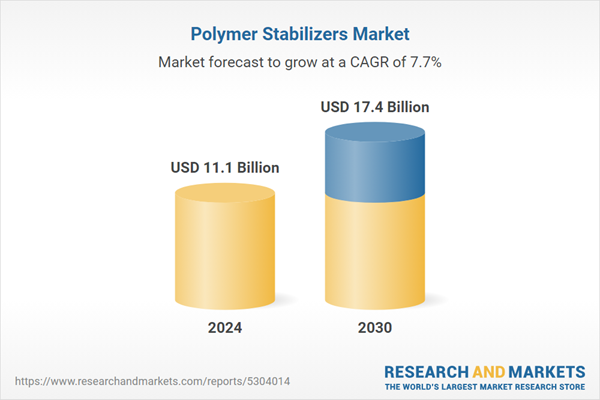Global Polymer Stabilizers Market - Key Trends & Drivers Summarized
What Are Polymer Stabilizers and Why Are They Crucial in Polymer Processing?
Polymer stabilizers are essential chemical additives used during the polymerization and manufacturing process to enhance the longevity, performance, and durability of polymers. These stabilizers are crucial for protecting polymers from various forms of degradation, such as thermal, oxidative, and UV-induced deterioration, which can occur during processing and throughout the product's life cycle. Typically, polymers like polyvinyl chloride (PVC), polyethylene (PE), and polypropylene (PP) are susceptible to environmental stresses, which lead to discoloration, brittleness, and a loss of mechanical properties. Polymer stabilizers are incorporated into the polymer matrix to mitigate these effects and ensure that the materials maintain their integrity over time.There are several types of polymer stabilizers, each serving a specific purpose. For instance, UV stabilizers protect polymers from ultraviolet light degradation, antioxidants prevent oxidative damage, and heat stabilizers, such as calcium-zinc and tin-based stabilizers, prevent thermal degradation during high-temperature processing. The use of these stabilizers is critical in industries such as packaging, automotive, construction, and electronics, where polymers are exposed to various environmental factors. With the growing demand for lightweight, durable, and cost-effective materials, the role of polymer stabilizers in ensuring product performance and longevity has become increasingly significant.
How Are Technological Innovations Shaping the Polymer Stabilizers Market?
Technological advancements are playing a transformative role in the development of polymer stabilizers, leading to the creation of more efficient and environmentally friendly stabilizer systems. Traditionally, lead-based stabilizers were widely used in industries like construction, particularly in PVC applications, but environmental concerns and regulatory restrictions have pushed the industry toward non-toxic alternatives. Today, calcium-zinc and organic-based stabilizers are becoming more prevalent, offering safer, non-hazardous options without compromising performance. Innovations in nanotechnology are also influencing the market, with the development of nano-sized stabilizers that enhance dispersion within the polymer matrix, offering better protection with lower additive concentrations.Moreover, there is a growing trend toward multifunctional stabilizers, which combine properties such as heat and UV stabilization into a single additive, reducing the overall additive load and simplifying processing requirements. These advancements are particularly valuable in sectors like automotive and packaging, where polymers are exposed to a range of environmental factors, and manufacturers seek to improve efficiency. Furthermore, advancements in analytical techniques and polymer science have led to better understanding of degradation mechanisms, allowing for the development of tailored stabilizer systems for specific applications. This trend toward customization is driving the adoption of more specialized and application-specific stabilizers across various industries.
Which End-Use Industries Are Driving Demand for Polymer Stabilizers?
The demand for polymer stabilizers is being driven by their extensive use across a broad range of end-use industries, each with its own unique requirements for material performance. The packaging industry, for example, is one of the largest consumers of polymer stabilizers, as packaging materials, particularly those made from polyethylene and polypropylene, need to withstand exposure to light, oxygen, and fluctuating temperatures without compromising product integrity. In this industry, UV stabilizers are critical to preventing polymer degradation during both production and storage, ensuring that packaging materials maintain their structural properties over time. Additionally, stabilizers help extend the shelf life of products by preserving the packaging materials from environmental wear and tear.The automotive sector is another key market for polymer stabilizers, as the trend towards lightweight vehicles continues to drive demand for durable plastic components. From dashboards to under-the-hood applications, automotive plastics must withstand harsh conditions, including high temperatures, chemicals, and UV radiation. Polymer stabilizers ensure that these materials maintain their mechanical strength, flexibility, and color stability throughout their lifespan. Similarly, the construction industry relies heavily on stabilizers to enhance the durability of polymer-based building materials such as pipes, window frames, and insulation. In electrical and electronics applications, stabilizers play a critical role in preserving the performance of polymers used in cables, connectors, and other components that are regularly exposed to heat and UV light.
What Factors Are Driving Growth in the Polymer Stabilizers Market?
The growth in the polymer stabilizers market is driven by several factors, including advancements in stabilizer technology, increasing demand from key end-use industries, and evolving consumer preferences for more durable and sustainable products. One of the most significant growth drivers is the push toward environmentally friendly stabilizers. With stricter regulatory frameworks being implemented globally to reduce the environmental impact of chemicals, manufacturers are increasingly shifting away from traditional lead-based and other hazardous stabilizers to non-toxic alternatives, such as calcium-zinc and organic stabilizers. This shift is particularly prominent in regions like Europe, where stringent environmental regulations such as REACH and RoHS are driving the adoption of eco-friendly stabilizer systems.Another key driver is the growing demand for lightweight materials in industries such as automotive and aerospace, where polymers are used extensively to reduce vehicle weight and improve fuel efficiency. These industries require polymers with enhanced durability and stability to withstand extreme conditions, fueling the need for advanced stabilizer solutions. Consumer behavior is also playing a role in driving market growth, as end-users demand products that are not only high-performing but also long-lasting and resistant to environmental degradation. This shift is particularly noticeable in the packaging industry, where there is increasing demand for packaging materials that offer extended shelf life and recyclability.
Finally, the rapid pace of industrialization and urbanization in emerging economies is contributing to the expansion of the polymer stabilizers market. As infrastructure development accelerates in regions such as Asia-Pacific and Latin America, there is rising demand for construction materials, automotive components, and packaging solutions, all of which rely on high-performance polymers. The growing middle class in these regions is also driving demand for consumer goods, electronics, and home appliances, further boosting the need for durable and stable polymer materials.
Report Scope
The report analyzes the Polymer Stabilizers market, presented in terms of market value (US$ Thousand). The analysis covers the key segments and geographic regions outlined below.- Segments: Type (Heat Stabilizer, Antioxidant, Light Stabilizer, Other Types); End-Use (Packaging, Building & Construction, Consumer Goods, Automotive, Other End-Uses).
- Geographic Regions/Countries:World; United States; Canada; Japan; China; Europe (France; Germany; Italy; United Kingdom; Spain; Russia; and Rest of Europe); Asia-Pacific (Australia; India; South Korea; and Rest of Asia-Pacific); Latin America (Argentina; Brazil; Mexico; and Rest of Latin America); Middle East (Iran; Israel; Saudi Arabia; United Arab Emirates; and Rest of Middle East); and Africa.
Key Insights:
- Market Growth: Understand the significant growth trajectory of the Heat Stabilizer segment, which is expected to reach US$6.4 Billion by 2030 with a CAGR of a 8.7%. The Antioxidant segment is also set to grow at 7.6% CAGR over the analysis period.
- Regional Analysis: Gain insights into the U.S. market, valued at $2.8 Billion in 2024, and China, forecasted to grow at an impressive 11.9% CAGR to reach $4.4 Billion by 2030. Discover growth trends in other key regions, including Japan, Canada, Germany, and the Asia-Pacific.
Why You Should Buy This Report:
- Detailed Market Analysis: Access a thorough analysis of the Global Polymer Stabilizers Market, covering all major geographic regions and market segments.
- Competitive Insights: Get an overview of the competitive landscape, including the market presence of major players across different geographies.
- Future Trends and Drivers: Understand the key trends and drivers shaping the future of the Global Polymer Stabilizers Market.
- Actionable Insights: Benefit from actionable insights that can help you identify new revenue opportunities and make strategic business decisions.
Key Questions Answered:
- How is the Global Polymer Stabilizers Market expected to evolve by 2030?
- What are the main drivers and restraints affecting the market?
- Which market segments will grow the most over the forecast period?
- How will market shares for different regions and segments change by 2030?
- Who are the leading players in the market, and what are their prospects?
Report Features:
- Comprehensive Market Data: Independent analysis of annual sales and market forecasts in US$ Million from 2024 to 2030.
- In-Depth Regional Analysis: Detailed insights into key markets, including the U.S., China, Japan, Canada, Europe, Asia-Pacific, Latin America, Middle East, and Africa.
- Company Profiles: Coverage of players such as Adeka Corporation, BASF SE, Chitec Technology Co. Ltd, Clariant, Evonik Industries AG and more.
- Complimentary Updates: Receive free report updates for one year to keep you informed of the latest market developments.
Some of the 43 companies featured in this Polymer Stabilizers market report include:
- Adeka Corporation
- BASF SE
- Chitec Technology Co. Ltd
- Clariant
- Evonik Industries AG
- PMC Group
- Polyvel Inc.
- SABO SpA
- SK Capital Partners
- Solvay
- Songwon
This edition integrates the latest global trade and economic shifts into comprehensive market analysis. Key updates include:
- Tariff and Trade Impact: Insights into global tariff negotiations across 180+ countries, with analysis of supply chain turbulence, sourcing disruptions, and geographic realignment. Special focus on 2025 as a pivotal year for trade tensions, including updated perspectives on the Trump-era tariffs.
- Adjusted Forecasts and Analytics: Revised global and regional market forecasts through 2030, incorporating tariff effects, economic uncertainty, and structural changes in globalization. Includes historical analysis from 2015 to 2023.
- Strategic Market Dynamics: Evaluation of revised market prospects, regional outlooks, and key economic indicators such as population and urbanization trends.
- Innovation & Technology Trends: Latest developments in product and process innovation, emerging technologies, and key industry drivers shaping the competitive landscape.
- Competitive Intelligence: Updated global market share estimates for 2025, competitive positioning of major players (Strong/Active/Niche/Trivial), and refined focus on leading global brands and core players.
- Expert Insight & Commentary: Strategic analysis from economists, trade experts, and domain specialists to contextualize market shifts and identify emerging opportunities.
Table of Contents
Companies Mentioned (Partial List)
A selection of companies mentioned in this report includes, but is not limited to:
- Adeka Corporation
- BASF SE
- Chitec Technology Co. Ltd
- Clariant
- Evonik Industries AG
- PMC Group
- Polyvel Inc.
- SABO SpA
- SK Capital Partners
- Solvay
- Songwon
Table Information
| Report Attribute | Details |
|---|---|
| No. of Pages | 289 |
| Published | December 2025 |
| Forecast Period | 2024 - 2030 |
| Estimated Market Value ( USD | $ 11.1 Billion |
| Forecasted Market Value ( USD | $ 17.4 Billion |
| Compound Annual Growth Rate | 7.7% |
| Regions Covered | Global |









